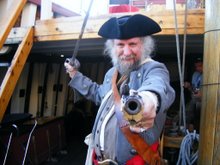- The main organizer, Nate, has been overwhelmed by his first child and by modifying a historic building so a lot less preparation went into this year's event. It is running on "auto-pirate".
- The weather was not kind to us. Friday was very hot - in the mid-90s. Saturday was a bit cooler. Sunday started cooler but got hot again in the afternoon.
- The event seems less like a pirate event and more like a generic one. In previous years there were a lot more displays and jolly roger flags visible.
- Attendance was down. One entire unit came down with the flu.
That said, it was still an enjoyable event.
Not a lot happened Friday. It was too hot. Also, there was not much breeze for sailing. Last year we had a dusk cannon firing and an improvised ship battle on Friday. This year we had cannon firing both Friday and Saturday but no ship battle.
On a personal note, my wife injured her knee Friday and could not walk without crutches.
I didn't get much sleep Friday night. Some musicians camped next to us played past 3 am. They ran out of period music around 1:30 and degenerated into "do you know this?" followed by a snatch of music. At five, my wife needed help going to the bathroom. At six the wind picked up, threatening rain so I had to quickly get things under cover.
The wind did cool things down. There was a slight drizzle a while later which blew over quickly.
The Saturday battle was cut short by an actual rainstorm. We go off a couple of shots before the guns became too wet to fire. The rain didn't last long.
Sunday's battle was far better. The Priddy Princess joined in as a British ship so we had a battle between it and the other boats. This was the second time I got to use the full-sized swivel gun on the Black Sheep. It was quite loud, matching the bigger pieces in the camp and outclassing the Princess's smaller swivel.
As always, the event had a variety of historic boats with people often going out sailing or rowing. The breeze was light so no one sailed very far from camp but it was common to see one or two boats on the lake.

